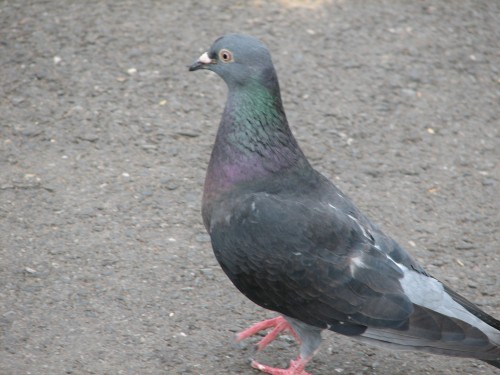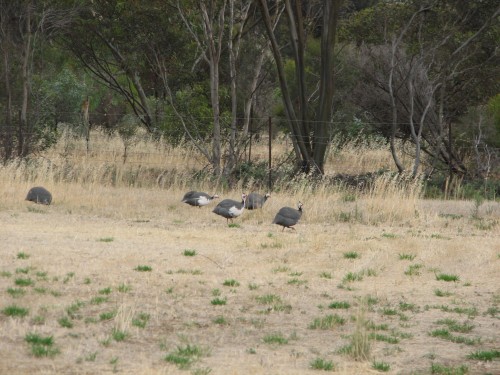Rock Dove
I don’t normally pay much attention to photographing introduced species, but this Rock Dove strutting around in the grounds of Adelaide Zoo caught my eye. It was almost right under my feet, the camera was ready to shoot and the bird was posing appropriately, so I took the photo.
Rock Doves, also called Feral Pigeons, are common throughout Australian cities and towns. They are especially common here in South Australia around cereal grain handling facilities, even in remote rural areas. The free grain available in such places provides a sustainable source of food. When I travelled overseas I discovered that they are very common in most places.
This individual, one of many, was feeding on food dropped by people visiting the zoo. The outdoor restaurant area was only a few metres behind me when I took the shot.
Green Peafowl, Adelaide Zoo
One of the more spectacular displays by any bird species would have to be that of the male (peacock) of the Indian Peafowl. A closely related species is the Green Peafowl, shown in the photos on this post. I took these photos in a walk through aviary at the Adelaide Zoo late last year. The male decided I wanted some beautiful photos of his amazing plumage and displayed it for my benefit.
The Indian Peafowl is more commonly known as a peacock, but that name should be reserved for only the male. It is native to the Indian sub-continent where I was able to see it in its natural habitat in the forest area of Royal Chitwan National Park in southern Nepal. You can read about my experiences on Trevor’s Travels. The Green Peafowl, however, is native to south east Asia and could well be extinct on the Indian sub-continent. Unlike the Indian Peafowl, the male and female Green Peafowl are very similar in the colours of their plumage.
The Indian Peafowl has been introduced into many countries and is commonly kept in zoos, private collections, parks and gardens. In some places there are semi-feral populations, including King and Flinders Islands in Tasmania, and Kangaroo Island here in South Australia.
Helmeted Guineafowl
Over the last 25 years I have observed well over a hundred different species of birds in our garden. I can’t give an exact number because my database is not up to date. I think it’s about 110. Some of the birds I have listed include introduced species (eg House Sparrow).
On at least two occasions in recent weeks we have had a visit from our neighbour’s Helmeted Guineafowl. We often hear them calling when we are out in the garden, but this is the first time we have actually seen them venture into our paddock.
I can’t include this as a species for my garden block list. Being domesticated birds they are not free living, so they can’t be included. In the photo below I managed to fluke taking a Galah in flight.
Helmeted Guineafowl are native to Africa. They eat insects and seeds and nest on the ground. They are large birds which measure from 40-71 cm in length, and weigh 700-1600 g.
A Starling in a hurry
Common Starlings are not my favourite birds.
In fact, here in Australia they are considered a pest, especially by fruit growers and people who have a few fruit trees in their back yard. A small flock can completely ruin a crop of apricots in a few hours, for example.
There is a wider environmental issue to also consider. Common Starlings are often found in flocks of hundreds and even number in the tens of thousands in fruit growing areas. Large flocks like this feed on the crops when they are ripe; for the rest of the year they are seriously depleting food sources of many of our native species. Even worse is the fact that they use tree hollows for their nests, thus denying native birds precious nesting sites. They are also very messy in their nesting habits, fouling the hollows to the point where only Starlings will reuse the hollow.
Last night I was at an outdoor function being conducted by our church. We hold this event on Sunday evenings every year in January in the town sound shell. Despite the very loudly amplified music the birding was spectacular. Not many species flew over, mind you, but one incident involving a Common Starling really caught my attention.
Two Australian Hobbies (Little Falcons) live around the CBD and I’ve seen them soaring around the area on a number of occasions. One of them zoomed past the sound shell at great speed heading for some trees in the park opposite. It did a few loops around a tall pine tree disturbing a Common Starling in the process which sped of in the opposite direction, hotly pursued by the falcon. Both disappeared behind a building. I hope that the falcon caught his supper.








